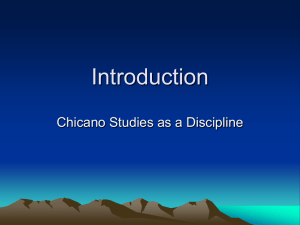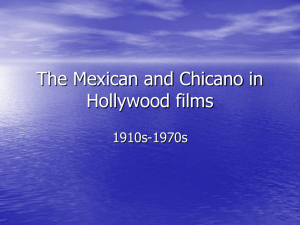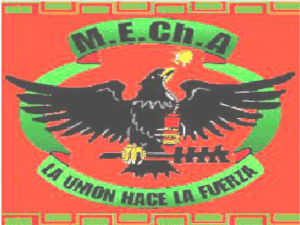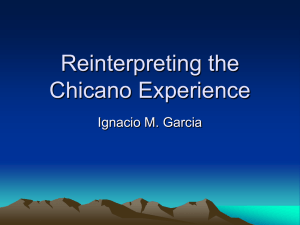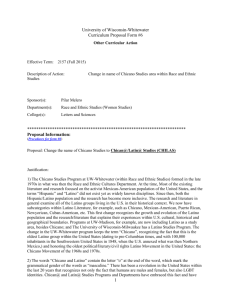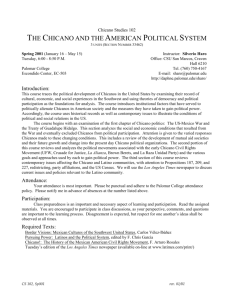course outline
advertisement
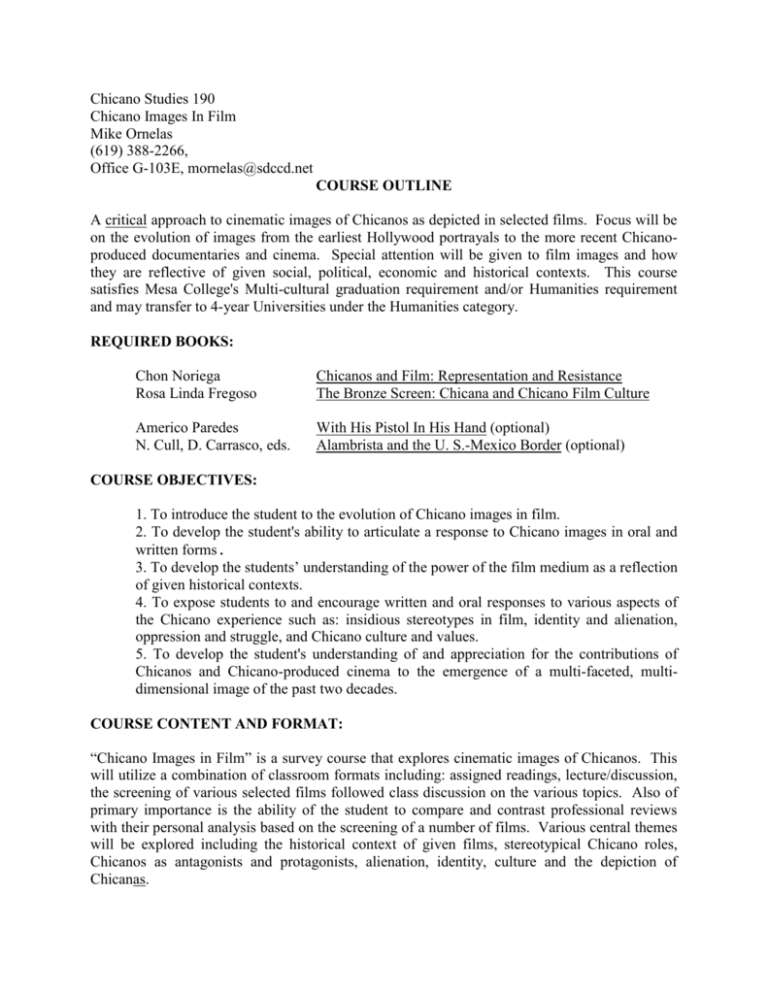
Chicano Studies 190 Chicano Images In Film Mike Ornelas (619) 388-2266, Office G-103E, mornelas@sdccd.net COURSE OUTLINE A critical approach to cinematic images of Chicanos as depicted in selected films. Focus will be on the evolution of images from the earliest Hollywood portrayals to the more recent Chicanoproduced documentaries and cinema. Special attention will be given to film images and how they are reflective of given social, political, economic and historical contexts. This course satisfies Mesa College's Multi-cultural graduation requirement and/or Humanities requirement and may transfer to 4-year Universities under the Humanities category. REQUIRED BOOKS: Chon Noriega Rosa Linda Fregoso Chicanos and Film: Representation and Resistance The Bronze Screen: Chicana and Chicano Film Culture Americo Paredes N. Cull, D. Carrasco, eds. With His Pistol In His Hand (optional) Alambrista and the U. S.-Mexico Border (optional) COURSE OBJECTIVES: 1. To introduce the student to the evolution of Chicano images in film. 2. To develop the student's ability to articulate a response to Chicano images in oral and written forms. 3. To develop the students’ understanding of the power of the film medium as a reflection of given historical contexts. 4. To expose students to and encourage written and oral responses to various aspects of the Chicano experience such as: insidious stereotypes in film, identity and alienation, oppression and struggle, and Chicano culture and values. 5. To develop the student's understanding of and appreciation for the contributions of Chicanos and Chicano-produced cinema to the emergence of a multi-faceted, multidimensional image of the past two decades. COURSE CONTENT AND FORMAT: “Chicano Images in Film” is a survey course that explores cinematic images of Chicanos. This will utilize a combination of classroom formats including: assigned readings, lecture/discussion, the screening of various selected films followed class discussion on the various topics. Also of primary importance is the ability of the student to compare and contrast professional reviews with their personal analysis based on the screening of a number of films. Various central themes will be explored including the historical context of given films, stereotypical Chicano roles, Chicanos as antagonists and protagonists, alienation, identity, culture and the depiction of Chicanas. Chicano Studies 190 Page 2 GRADES: Final grades will be determined through a combination of criteria that will include the following: Attendance and participation in class discussion will comprise 25% of the grade. Three, 5-7 page papers will be due during the semester. Each will comprise 25% of the final grade. A fourth paper may be turned in as an extra-credit assignment. Students should discuss this option with the instructor, should you choose to do it. These will be take-home assignments that focus on topics and themes that will be discussed in class and based upon particular reading assignments as well. You will be provided with the possible essay questions that cover the films to be viewed and the assigned readings. SCHEDULE OF FILMS, PAPERS AND READING ASSIGNMENTS: Date, Readings 1. October 24, 2005 Film Major Topic Intro to C. S. 190 2. October 26 The Bronze Screen Latinos in Hollywood Films Reading: Noriega, pp. xi-xxvi, 18-28, 29-46, 47-58, 59-73, 74-93. 3. October 31 Salt of the Earth (1954), Human courage and passion Reading: Fregoso, pp. xiii-xxiii, and pp. 1-20, Jose Limon, “Stereotyping and Chicano Resistance: An Historical Dimension” and Noriega, pp. 141-167, Noriega, pp. 229-231 4. November 2 Bread and Roses (2002) Workers’ rights and the undocumented Reading: Noriega, pp. 141-167, Noriega, pp. 229-231 5. November 7 Alambrista (1976, 2004) The undocumented struggle Reading: Cull, Carrasco: Alambrista and the U.S.-Mexico Border: Film, Music, and Stories… 6. November 9 El Norte (1983) Immigrant saga and the American dream Fregoso, pp. 106-110, and Noriega, pp. 207-217, 231-233, 248-249, and 254-256. 7. November 14 Reading: hand-outs My Family/Mi Familia (1995) The Chicano family romantic epic 8. November 16 American Me (1992) Olmosian visions and the dark tunnel Reading: Fregoso, pp. 122-134, pp. 21-48, Noriega, pp. 208-215, 226-228 9. November 21 Zoot Suit (1981) Reading: Fregoso, pp. 21-38. Multi-vocality, countervisionality Chicano Studies 190 Page 3 10. November 23 La Bamba (1987) “Tu eres mi otro yo” Reading: Fregoso, pp. 38-48 and Francisco X. Camplis, “Towards the Development of a Raza Cinema,” Noriega, pp. 208-215, 226-228 11. November 28 Born in East L.A. (1987) Humor and subversive deconstruction Reading: Fregoso, pp. 49-70 and Noriega, pp. 183-194, 213-217 12. November 30 Mi Vida Loca (1994) Hanging the Homegirls Reading: Rosa Linda Fregoso handout, “Hanging the Homegirls” 13. December 5 Reading: handouts Luminarias (2001) Chicanas in life and love, female autonomy 14. December 7 Reading: handouts Real Women Have Curves (2002) Chicana independence v. traditionalism 15. December 12 Last day of class, All papers due. In the event of an instructor absence or tardy, students should wait at least fifteen minutes before leaving, unless notified otherwise through the dean’s office. Most of the films listed above can be reviewed in the Audio Visual department--fourth floor of the library. Student identification is necessary and the films cannot be removed from the facility. Some are also available through Kensington Video as well as Blockbuster or Hollywood Video. Student Advisory: Many of the films viewed and discussed in class are rated “R”. Therefore some of them contain profanity, sexuality, overt sexual acts, and violence that include a racial dimension. Some students may find these acts to be offensive and contrary to their beliefs. But absence from class based on this is not excused or allowed. You are advised to drop this course and consider alternatives if you are so offended. Chicano Studies 190 Website: There is website for Chicano Studies 190 that contains important information for your use including the course outline, class notes, important Power Point presentations, and study guides. It has been constructed with you in mind and should be checked periodically as the information on the site may change through the course of the semester. You must have Power Point software on your computer or the Power Point viewer. The Power Point program must be purchased and is usually offered as a package from Microsoft. To download a free version of the viewer simply go to Microsoft.com and locate the viewer among Chicano Studies 190 Page 4 the various programs that are downloadable. To access the website do the following: 1. In your browser type in the web address at classroom.sdmesa.edu/mornelas 2. Select your class-Chicano Studies 190 3. Select course outline, announcements or Power Point presentations for the information you are trying to access. Other films available for your viewing/review: A Day Without a Mexican …and the earth did not swallow him,…y no se lo trago la tierra A Touch of Evil A Walk in the Clouds Bordertown Boulevard Nights Bound by Honor: Blood in, Blood Out Break of Dawn Distant Water Fools Rush In Giant Latino Lone Star One-Eyed Jacks Selena Stand and Deliver Star Maps The Ballad of Gregorio Cortez The Milagro Beanfield War The Price of Glory The Princess and the Barrio Boy The Ring The Wild Bunch The Wonderful Ice Cream Suit Tortilla Flats Tortilla Soup Treasure of the Sierra Madre Walk Proud
